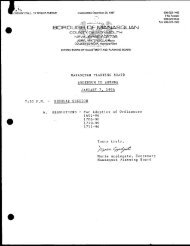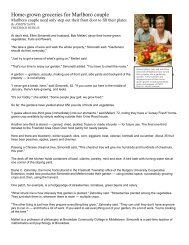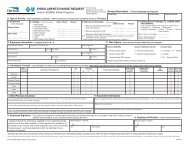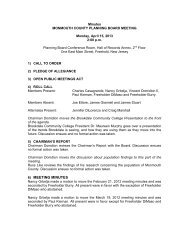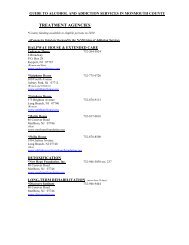NATURAL and CULTURAL FEATURES of MONMOUTH COUNTY
NATURAL and CULTURAL FEATURES of MONMOUTH COUNTY
NATURAL and CULTURAL FEATURES of MONMOUTH COUNTY
You also want an ePaper? Increase the reach of your titles
YUMPU automatically turns print PDFs into web optimized ePapers that Google loves.
BC, the bedrock was flooded by the rising ocean <strong>and</strong> filled by river sediments for the next 3000<br />
years, turning the fjord into an estuary (Blumberg et al., 2004; Geyer et al., 2001). During the<br />
late Wisconsinan glacial period, the Raritan River had flowed northeastward along the northern<br />
shore <strong>of</strong> Staten Isl<strong>and</strong> directly into the Hudson River, along the route <strong>of</strong> the present day Arthur<br />
Kill <strong>and</strong> the Kill van Kull (Gaswirth et al., 1999; USGS, 2007). When the Laurentide Ice Sheet<br />
eventually retreated, massive amounts <strong>of</strong> run<strong>of</strong>f from the melting glacier re-routed the river to<br />
the southeast into present day Raritan Bay (Gaswirth et al., 1999).<br />
Freshwater Discharges <strong>and</strong> Bay Hydrodynamics<br />
The New York-New Jersey Harbor Estuary consists <strong>of</strong> Upper <strong>and</strong> Lower New York Harbor<br />
(from the Battery to the Verrazano-Narrows Bridge), Newark Bay, <strong>and</strong> Raritan Bay (USACE,<br />
2004). Raritan Bay <strong>and</strong> S<strong>and</strong>y Hook Bay measures about 109 square miles, with a surface area <strong>of</strong><br />
about 69,188 acres, the inshore portion measuring about 33,500 acres (USFWS, 2007). The<br />
Estuary receives most <strong>of</strong> its freshwater flow from the Hudson <strong>and</strong> Raritan Rivers, <strong>and</strong> the Arthur<br />
Kill; <strong>and</strong> drains a watershed <strong>of</strong> about 16,300 square miles (NY/NJCOST, 2004; NY/NJHEP,<br />
2007); USGS, 2007). More than 85% <strong>of</strong> the freshwater discharged into the Bay passes<br />
underneath the Verrazano-Narrows Bridge, while the Raritan <strong>and</strong> Passaic Rivers contribute about<br />
14% (NY/NJCOST, 2004). Although the Raritan River discharges only 7% <strong>of</strong> the total<br />
freshwater, it dominates water quality along the Bay’s southern coast in Monmouth County,<br />
especially when heavy rain occurs during an ebbing tide (Jeffries, 1962; NY/NJCOST, 2004;<br />
USGS, 2007). In Monmouth County, the Navesink-Shrewsbury Rivers, four lakes from<br />
Aberdeen to Union Beach, <strong>and</strong> numerous streams throughout the Bayshore flow into the Bay.<br />
The residence for Bay water is about 60 tidal cycles or 16 to 21 days; the Hudson River Estuary<br />
flushes in less than 40 days during the high inflow periods in the spring, while during the<br />
summer low flow periods it takes about 200 days to flush (Blumberg et al., 2004; Geyer et al.,<br />
2001; Jeffries, 1962; Stehlik et al., 2004; Zimmer, 2004). Water depths in Raritan Bay average<br />
less than 20 feet deep outside the dredged channels; the easternmost part <strong>of</strong> the bay is somewhat<br />
deeper (Ray, 2004; USFWS, 2007). Dredged channels in Raritan Bay <strong>and</strong> S<strong>and</strong>y Hook Bay<br />
range from 80 to 1400 feet wide, <strong>and</strong> from 10 to 35 feet deep (Ray, 2004; USFWS, 2007). The<br />
mean tidal range is about 5.5 feet, but storm surges can reach 12 feet or higher (USGS, 2007).<br />
Raritan Bay tidal currents are counterclockwise, with major inward flows along the north shore<br />
(NY) from the Ambrose Channel, <strong>and</strong> outward flows moving along the southern shore<br />
(Monmouth County) exiting through the S<strong>and</strong>y Hook Channel (Ray, 2004; USFWS, 2007). The<br />
average flood tide into the bay flows about 2 knots at the Ambrose Channel entrance while the<br />
ebb tide is generally stronger than the flood tide by 10% or more (the 76-foot high Ambrose<br />
Lighthouse marks the entrance to Ambrose Channel, which is the principal deepwater channel<br />
into Raritan Bay) (MBEC, 1976; Sorensen, 2005). Salinities range from a low <strong>of</strong> about 12 ppt<br />
near the mouth <strong>of</strong> the Raritan River to 32 ppt at S<strong>and</strong>y Hook (USGS, 2007). Since the difference<br />
in density between salt <strong>and</strong> fresh water is about 3.5% or less, denser salt water enters the estuary<br />
in the lower part <strong>of</strong> the water column, while the lighter fresh water floats on top (Blumberg et al.,<br />
2004). Water temperatures in Raritan Bay range from about 33 F in January to 78 F in late<br />
August (USGS, 2007).<br />
The Hudson-Raritan plume discharges an average <strong>of</strong> 23,000 million gallons a day <strong>of</strong> freshwater<br />
into the ocean through a five <strong>and</strong> a half mile opening between S<strong>and</strong>y Hook, NJ <strong>and</strong> Rockaway<br />
Point, NY, where the bottom is armored with pea gravel due to the fast-moving tidal flow<br />
(Jeffries, 1962; NJ Scuba Diver, 2005; NY/NJCOST, 2004). In contrast, water entering the Bay




